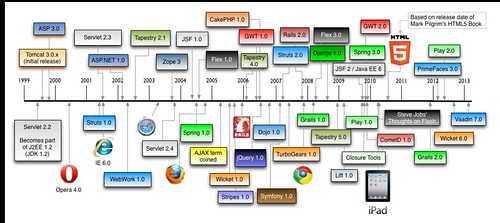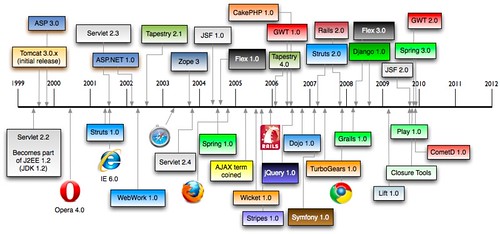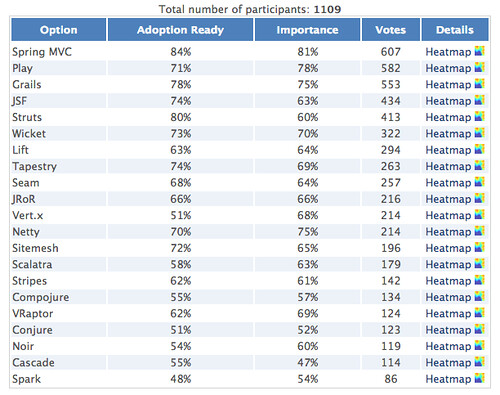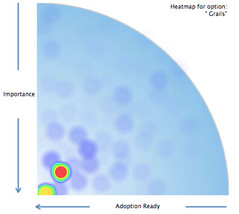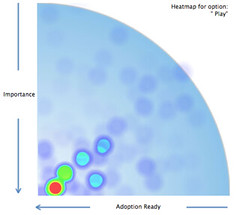This week, I'm at Jfokus in Stockholm, Sweden. After a fun speaker's dinner last night, I got up this morning and polished up my presentations and demo before attending the conference. The first session I attended was Peter Hilton's Play Framework 2.0 presentation. Below are my notes from this talk.
Peter is a Senior Web Developer, not a Java Developer. His first slide states the following:
"Play brings type safe high-productivity web development to the JVM."
New features in Play 2.0: type-safety, template syntax, compile-time checking and asynchronous HTTP programming. Java, Scala - the language you use is less important than the fact that Play is a web framework. It's a full-stack framework and has everything you need out-of-the-box to build a web application. Play focuses on HTTP and doesn't try to hide it. It's designed by web developers for web developers.
With Play, the Back button just works. Your web framework shouldn't break the first button on your browser's toolbar. The Reload button also works: make a change, hit reload and your changes (even in Scala classes) are shown. You design the URLs and you can use "clean" URLs. DX (Developer eXperience) is Peter's new term. Usability matters: as a developer, you deserve a framework that provides a good experience.
Play doesn't fight HTTP or the browser. It's stateless and HTTP-centric. A few years ago, it seemed like a good idea to try and keep state on the server. It sounded like a good idea, but in practice, it's a really bad idea - especially for things like the back button. Play matches the web's stateless HTTP architecture.
As a Java EE developer, PHP and Rails developers have been laughing at us for years. Like Father Christmas, Peter's heard of class-reloading, but he hasn't actually seen it. Code reloading is the most important part of DX and about achieving high-productivity in web development.
URLs want to be loved too. REST architecture isn't just for web service APIs. When you have clean URLs, you can tweet them, post them and email them.
"You would need to be a super-hero to successfully use some web frameworks." They show you a blank screen in the browser and you have to look at your console's stack trace to figure it out. With Play, the error is shown in your browser and you can see the exact line it happens on.
In Play 1.x, there was a lot of magic and a lot of bytecode enhancement at runtime. This allowed the API to be a lot nicer than traditional Java APIs. However, it caused issues when users viewed the enhanced source and it also caused issues in IDEs. With Play 2.0, the framework itself is implemented in Scala. Scala removes the need for so much bytecode enhancement. There is less 'magic' and strangeness in the API. The code you see in the IDE is the code that runs. Scala source code is not necessarily harder to read. 1.x had some pretty hairy Java code, and you could tell when you dug into it. Especially when you were deep into the source code and saw that a lot of the comments were in French.
Play 2.0's template system is based on Scala. It's similar to the lightweight template syntax in Play 1.x. Templates are compiled into class files for run-time speed. For example:
@(products: Seq[Product])
<ul>
@for(product <- products) {
<li>@product.name</li>
}
</ul>
@summary(products)
We used to think XML-based templates were great, but it turns out it's a terrible idea. Mostly because you end up having to invent an expression language to create valid XML (to avoid putting XML in your HTML attributes). With Play 2.0's templates, you can define tags in your templates as regular Scala methods.
@display(product: models.Product) ={
<a href="@routes.Product.details(product.id)">@product.name</a>
}
@for(product <- products) {
@display(product)
}
The compile-time checking in Play 2.0 is not just for Java and Scala classes. It also compiles your HTTP routes file (which maps requests to controller actions). Furthermore, it compiles your templates, JavaScript files (using Google Closure Compiler), CoffeeScript files and LESS stylesheets.
Play supports modern web development. It's designed to work with HTML5, but there's no constraints on HTML output. It's front-end developer friendly and has great DX. UI components belong in the client, e.g. jQuery UI. It also has built-in support for improvements to CSS (LESS) and JavaScript (CoffeeScript).
A few years ago, it seemed like a really good idea to hide JavaScript from the web developer. Web frameworks used to say "You don't need to see the JavaScript or the HTML, we'll handle generating your components for you." Now, if you're building a web application and you don't know any jQuery, you doing it the hard way. You should learn how to work with front-end developers or learn how to do it yourself. And make sure your web framework allows this sort of development.
The future of web programming is asynchronous. You'll perform simultaneous web service requests. You'll process streams of data, instead of filling up memory or disk. You'll publish real-time data and have predictable and minimal resource consumption. In the long term, this changes everything. The future of the web is real-time and asynchronous. With Play 2.0, it's not just another feature, it's a fundamental aspect of the architecture. Play's internal architecture uses a reactive model based on Iteratee IO.
In summary, use Play 2, use HTML5, deploy to the Cloud. There's two forthcoming books on Play (both from Manning) and Play 2.0 RC1 will be released today.
I think Peter did a good job of summarizing the new features in Play 2.0, especially how templates work. I enjoyed his emphasis on HTTP and how Play leverages the browser (back, reload and as a console). I liked his humorous speaking style, and agree with his emphasis that client-side development skills are important for modern web applications. I think Play 2.0 is making a big bet on Scala and asynchronous programming, but if they live up to the hype, it should be a very enjoyable web framework to develop with.




